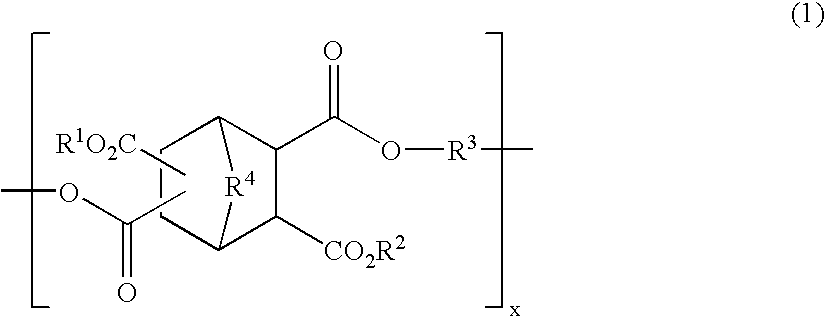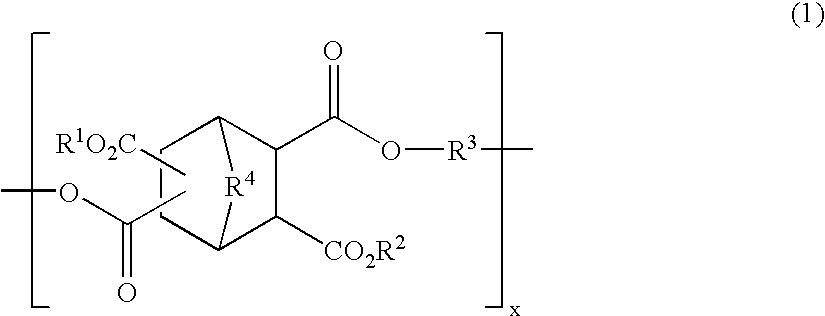Polyester compound and resist material using the same
a polymer compound and resist material technology, applied in the field of vacuum-ultraviolet resist material and patterning method, can solve the problems of other physical properties of the (meth)acrylic ester resin required for use as the resist material, research does not yet reach a certain cause of ler, and ler could be caused
- Summary
- Abstract
- Description
- Claims
- Application Information
AI Technical Summary
Benefits of technology
Problems solved by technology
Method used
Image
Examples
example 1
Synthesis of Polyester Compound (13)
[0066]
[0067]Bicyclo[2.2.2]octane-2,3:5,6-tetracarboxylic acid anhydride (7) (5.51 g) and 1,4-butadiol (3a) (2.19 g) were mixed into N,N-dimethylformamide (44.0 ml) within a 100-ml four-neck flask. The resultant mixed solution was cooled in an ice-water bath so that the internal temperature of the mixed solution reached 5° C., followed by dropping triethylamine (4.97 g) into the solution with stirring over 15 minutes. After that, the solution was stirred for 5 minutes under ice-water cooling, heated to 50° C. in an oil bath and stirred for 8 hours. This reaction solution was left and cooled, and then, dropped into acetone (2,000 ml) with stirring over 30 minutes under a room temperature condition to reprecipitate a powdery substance out of the solution. After the solution was stirred for further 1 hour, the precipitate powder was recovered by suction filtration. The recovered powder was dissolved into methanol (40 ml). The solution was dropped into...
example 2
Synthesis of Polyester Compound (14)
[0068]
[0069]Bicyclo[2.2.2]octane-2,3:5,6-tetracarboxylic acid anhydride (4) (10.18 g) and cyclohexane-1,4-dimethanol (3b) (6.20 g) were mixed into toluene (44.0 ml) within a 100-ml four-neck flask, followed by adding thereto methanesulfonic acid (0.38 g). The resultant mixed solution was heated to 80° C. in an oil bath and stirred for 5 hours. At this time, a resin precipitate was observed in the reaction solution. After the reaction solution was left and cooled, acetone (88.0 ml) was added into the solution to dissolve the precipitate. A part of the precipitate was considered to be a high molecular weight component and left in a swelling state without being dissolved in the solution. This swelling component was removed by filtration. The filtrate was dropped into n-hexane (2,000 ml) with stirring over 1 hour under a room temperature condition to reprecipitate a powdery substance. After the solution was stirred for further 1 hour, the precipitate ...
example 3
Synthesis of Polyester Compound (15)
[0070]
[0071]Bicyclo[2.2.2]octane-2,3:5,6-tetracarboxylic acid anhydride (4) (5.13 g) and 2-(1,1,1,3,3,3-hexafluoro-2-hydroxyisopropyl)cyclohexane-1,4-diol (3c) (6.13 g) were mixed into toluene (21.7 ml) within a 100-ml four-neck flask, followed by adding thereto methanesulfonic acid (0.27 g). The resultant mixed solution was heated to 80° C. in an oil bath and stirred for 18 hours. This reaction solution was left and cooled, and then, dropped into n-hexane (2,000 ml) with stirring over 1 hour under a room temperature condition to reprecipitate a powdery substance out of the solution. After the solution was stirred for further 1 hour, the precipitate powder was recovered by suction filtration. The recovered powder was dried for 6 hours at 50° C. in an oven under a reduced pressure, thereby yielding a white powdery reaction product (9.30 g). The molecular weight (Mw) and the molecular-weight distribution (Mw / Mn) of the reaction product were determin...
PUM
| Property | Measurement | Unit |
|---|---|---|
| reaction temperature | aaaaa | aaaaa |
| temperature | aaaaa | aaaaa |
| wavelengths | aaaaa | aaaaa |
Abstract
Description
Claims
Application Information
 Login to View More
Login to View More - R&D
- Intellectual Property
- Life Sciences
- Materials
- Tech Scout
- Unparalleled Data Quality
- Higher Quality Content
- 60% Fewer Hallucinations
Browse by: Latest US Patents, China's latest patents, Technical Efficacy Thesaurus, Application Domain, Technology Topic, Popular Technical Reports.
© 2025 PatSnap. All rights reserved.Legal|Privacy policy|Modern Slavery Act Transparency Statement|Sitemap|About US| Contact US: help@patsnap.com



